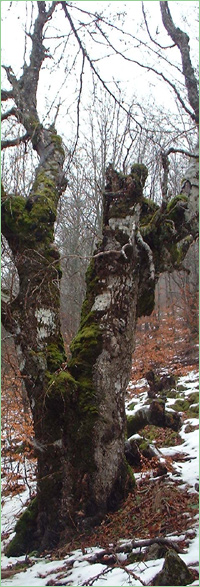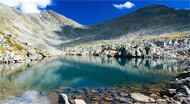Reka Mesta (Unique identification code in the register: BG0001021)
Category: PZ under the Habitat Directive
Area: 19401.69 hectares Location:
1.
District: Blagoevgrad, Municipality: Bansko, Locality: Bansko, Dobrinishte, Filipovo, Gostun, Kremen, Obidim, Osenovo
2.
District: Blagoevgrad, Municipality: Belitsa, Locality: Gorno Kraishte
3.
District: Blagoevgrad, Municipality: Garmen, Locality: Baldevo, Osikovo, Ribnovo, Skrebatno
4.
District: Blagoevgrad, Municipality: Gotse Delchev, Locality: Banichan, Breznitsa, Bukovo, Gospodintsi, Kornitsa, Lazhnitsa
5.
District: Blagoevgrad, Municipality: Razlog, Locality: Banya, Eleshnitsa
Falls in the territory of the following Regional Inspectorates of Environment and Water (RIEW):
Blagoevgrad - ul."Svoboda" № 1
Ordinance for announcement:
Ordinance No.РД-353 from 31.03.2021
2-2-1021-353-2021
Record for protected zone (link):

Aims of the declaration:
1. Preservation and maintenance of the types of natural habitats specified in item 2.1, the habitats of the species specified in item 2.2, their populations and distribution within the boundaries of the zone, to achieve and maintain their favorable nature conservation status in the Alpine biogeographical region;
2. Increase the contribution of the protected area to the area of natural habitats with codes 5210, 6210 (* important orchid habitats) and 6220*;
3. Improving the structure and functions of natural habitats with codes 3260, 3270, 6210 (* important orchid habitats), 6220*, 6430, 6520, 7140, 9180*, 91E0*, 91M0, 91W0, 9530* and 95A0;
4. Improvement of the habitats of the species Emys orbicularis;
5. If necessary, improving the condition or restoring the types of natural habitats specified in item 2.1, habitats of species specified in item 2.2 and their populations;
6. Maintaining the connectivity of the habitats of the conservation priority species Ursus arctos and Canis lupus.
Objects of protection (species or habitats):
1. Article 6, paragraph 1, section 1 from Biological Diversity Act: 3260 Water courses of plain to montane levels with the Ranunculion fluitantis and Callitricho-Batrachion;
3270 Rivers with muddy banks with Chenopodion rubri and Bidention p.p.;
4060 Alpine and Boreal heaths;
5210 Arborescent matorral with Juniperus spp.;
6110 * Rupicolous calcareous or basophilic grasslands of the Alysso-Sedion albi;
6210 Semi-natural dry grasslands and scrubland facies on calcareous substrates (Festuco-Brometalia) (*important orchid habitats);
6220 * Pseudo-steppe with grasses and annuals of the Thero-Brachypodietea;
6430 Hydrophilous tall herb fringe communities of plains and of the montane to alpine levels;
6510 Lowland hay meadows;
6520 Mountain hay meadows;
7140 Transition mires and quaking bogs;
8210 Calcareous rocky slopes with chasmophytic vegetation;
8230 Siliceous rock with pioneer vegetation of the Sedo-Scleranthion or Sedo albi-Veronicion dillenii;
8310 Caves not open to the public;
9110 Luzulo-Fagetum beech forests;
9130 Asperulo-Fagetum beech forests;
9170 Galio-Carpinetum oak-hornbeam forests;
9180 * Tilio-Acerion forests of slopes, screes and ravines;
91AA * Eastern white oak woods;
91BA Moesian silver fir forests;
91CA Rhodopide and Balkan Range Scots pine forests;
91D0 * Bog woodland;
91E0 * Alluvial forests withAlnus glutinosa and Fraxinus excelsior (Alno-Pandion, Alnion incanae, Salicion albae);
91M0 Pannonian-Balkanic turkey oak-sessile oak forests;
91W0 Moesian beech forests;
9410 Acidophilous Picea forests of the montane to alpine levels (Vaccinio-Piceetea);
9530 * (Sub-) Mediterranean pine forests with endemic black pines;
95A0 High oro-Mediterranean pine forests;
2. Article 6, paragraph 1, section 2 from Biological Diversity Act: Mammals - Ursus arctos, Canis lupus, Rupicapra rupicapra balcanica, Lutra lutra, Vormela peregusna, Rhinolophus ferrumequinum, Rhinolophus hipposideros, Rhinolophus euryale, Rhinolophus blasii, Myotis myotis, Myotis bechsteinii, Myotis capaccinii, Myotis blythii, Myotis emarginatus, Miniopterus schreibersii, Barbastella barbastellus;
Amphibians and reptiles - Bombina variegata, Triturus karelinii, Emys orbicularis, Testudo hermanni, Testudo graeca;
Fish - Cobitis taenia, Rhodeus amarus, Barbus cyclolepis;
Intervertebrates - Austropotamobius torrentium, Lucanus cervus, Cerambyx cerdo, Morimus funereus, Rosalia alpina, Osmoderma eremita, Polyommatus eroides, Euplagia Callimorpha quadripunctaria, Paracaloptenus caloptenoides.
Current prohibitions and regimes:
1. It is prohibited conducting races with motor vehicles outside the existing roads and the places regulated for that;
2. It is prohibited movement of motorcycles, ATVs, UTVs and buggies off existing roads in non-urban areas. The prohibition does not apply to routes for the movement of the listed motor vehicles determined on the basis of a normative act, as well as in case of disasters, emergencies and for carrying out fire-fighting, emergency, control and rescue activities;
3. It is prohibited the prospecting for minerals (construction and stone materials), creating new and expanding concession areas for extraction of minerals (construction and stone materials); prohibition does not apply in cases where the date of publication of the order in the "Official Gazette" has started a procedure for granting permits for prospecting and / or exploration and / or the concession for extraction under Subsurface Resources Act (SRA) and Concessions Act, or a procedure for their coordination under Chapter Six of the Law on environmental protection and / or art. 31 of the Biological Diversity Act or an application for registration of a commercial discovery;
4. It is prohibited to change the way of permanent use, plowing, afforestation and conversion into permanent plantations of meadows, pastures and grassland, when using agricultural lands as such;
5. It is prohibited to plow and afforest meadows, barren lands and other unforested forest territories within the boundaries of non-forest natural habitats under item 2.1 except in cases of proven need for protection against erosion and flood rain, as well as in cases of implementation of eligible plans, programs, projects or investment proposals approved in accordance with environmental legislation;
6. It is prohibited to remove landscape features (borders, vital single trees and groups of trees, traditional strips occupied by shrub and tree vegetation among lands under cultivation, protective forest belts, stone fences and hedges), when using agricultural land as such, except in cases to removal of invasive alien species of trees and shrubs;
7. It is prohibited the use of fertilizers, soil improvers, biologically active substances, nutrient substrates and plant protection products that do not meet the requirements of the Plant Protection Act;
8. It is prohibited the use of mineral fertilizers in meadows, pastures, grasslands, abandoned agricultural lands and forest areas, as well as plant protection products of professional category of use in these areas except for calamity, epiphytosis or the use of selective methods to combat invasive alien species;
9. It is prohibited to use of organic sludge from industrial and other waters and household waste for introduction into agricultural land without permission from the specialized bodies of the Ministry of Agriculture, Food and Forestry and when the concentration of heavy metals, metalloids and persistent organic pollutants in sludge exceeds background concentrations according to Annex № 1 of Ordinance № 3 of 2008 on the norms for permissible content of harmful substances in soils (SG, issue 71 of 2008);
10. It is prohibited to use of irrigation water that contains harmful substances and waste above the permissible norms;
11. It is prohibited burning of stubble, syllables, roadside strips and areas with dry and moisture-loving vegetation;
12. It is prohibited to make a fire, improvements, electrification, conduct of business and sports activities in the caves and caves' entrances, as well as to break, damage, to collect or to remove of rock and cave formations, and also to divide the cave's entrance or its individual galleries in a way that prevents passing of species subject to protection under item 2.2.1;
13. It is prohibited conducting speleological research during the breeding season of bats - from March 1 to June 30;
14. It is prohibited to drainage of coastal floodplains of rivers and other natural water bodies , changes in the hydromorphological regime through drainage, removal of sediments, correction, barricading of rivers, except in cases in urban areas and in cases of flood danger, which may lead to a risk to human life and health or the occurrence of material damage, in case of disasters and accidents and to improve the condition of the natural habitats and the habitats of the species under item 2.
15. It is prohibited carrying out felling in natural habitat with code 91E0 *, except for the needs of facilities (elements) of the technical infrastructure, for prevention of dangers endangering human life and health, in case of disasters and accidents, for maintenance / improvement of natural habitats and habitats of the species under item 2, as well as in the cases of realization of admissible investment proposals, approved by the order of the ecological legislation;
16. It is prohibited extraction of wood and biomass in forests in the old age phase, except in cases of damage of more than 50% of the area of the respective forest in the old age phase due to natural disasters and calamities; in old age forests, through which existing forest roads and other infrastructure objects pass, if proven necessary, felling of single dry, damaged, endangered or obstructing the safe movement of people and vehicles or the normal functioning of infrastructure objects trees is allowed;
17. It is prohibited grazing of domestic animals in forest areas, which are designated for forests in the old age phase.
18. It is prohibited construction of roads of second and higher class without ensuring the construction of appropriate green infrastructure for crossing of bears and other animals.
Overlapping (partial or full):
1.
Natural Monument: Skalnoto obrazuvanie Kupena
2.
Natural Monument: Skalnoto obrazuvanie Svatbata
3.
PZ under the Bird Directive: Mesta
4.
PZ under the Bird Directive: Pirin bufer

|
|

|





